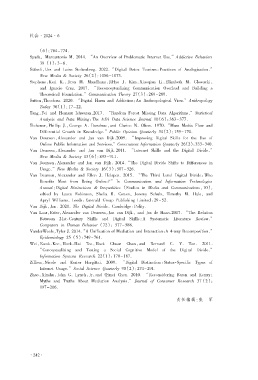Page 249 - 《社会》2024年第6期
P. 249
社会·2024·6
(6):764-774.
Spada, Marcantonio M. 2014. “An Overview of Problematic Internet Use.” Addictive Behaviors
39 (1):3-6.
St覿heli,Urs and Luise Stoltenberg. 2022.“Digital Detox Tourism:Practices of Analogization.”
New Media & Society 26(2):1056-1073.
Stephens,Keri K.,Dron M. Mandhana,JiHye J. Kim,Xiaoqian Li,Elizabeth M. Glowacki,
and Ignacio Cruz. 2017. “Reconceptualizing Communication Overload and Building a
Theoretical Foundation.” Communication Theory 27(3):269-289.
Sutton,Theodora. 2020. “Digital Harm and Addiction:An Anthropological View.” Anthropology
Today 36(1):17-22.
Tang,Fei and Hemant Ishwaran.2017. “Random Forest Missing Data Algorithms.” Statistical
Analysis and Data Mining:The ASA Data Science Journal 10(6):363-377.
Tichenor,Phillip J.,George A. Donohue,and Clarice N. Olien. 1970.“Mass Media Flow and
Differential Growth in Knowledge.” Public Opinion Quarterly 34(2):159-170.
Van Deursen,Alexander and Jan van Dijk.2009. “Improving Digital Skills for the Use of
Online Public Information and Services.” Government Information Quarterly 26(2):333-340.
Van Deursen,Alexander and Jan van Dijk.2011. “Internet Skills and the Digital Divide.”
New Media & Society 13(6):893-911.
Van Deursen,Alexander and Jan van Dijk. 2014.“The Digital Divide Shifts to Differences in
Usage.” New Media & Society 16(3):507-526.
Van Deursen,Alexander and Ellen J. Helsper. 2015. “The Third Level Digital Divide:Who
Benefits Most from Being Online?” In Communication and Information Technologies
Annual:Digital Distinctions & Inequalities (Studies in Media and Communications,10),
edtied by Laura Robinson, Shelia R. Cotten, Jeremy Schulz, Timothy M. Hale, and
Apryl Williams. Leeds:Emerald Group Publishing Limited:29-52.
Van Dijk,Jan. 2020. The Digital Divide. Cambridge:Polity.
Van Laar,Ester,Alexander van Deursen,Jan van Dijk, and Jos de Haan.2017. “The Relation
Between 21st鄄Century Skills and Digital Skills:A Systematic Literature Review.”
Computers in Human Behavior (72): 577-588.
VanderWeele,Tyler J. 2014.“A Unification of Mediation and Interaction:A 4鄄way Decomposition.”
Epidemiology 25 (5):749-761.
Wei,Kwok鄄Kee,Hock鄄Hai Teo,Hock Chuan Chan,and Bernard C. Y. Tan. 2011.
“Conceptualizing and Testing a Social Cognitive Model of the Digital Divide.”
Information Systems Research 22(1):170-187.
Zillien,Nicole and Eszter Hargittai. 2009. “Digital Distinction:Status鄄Specific Types of
Internet Usage.” Social Science Quarterly 90(2):274-291.
Zhao,Xinshu,John G. Lynch,Jr,and Qimei Chen. 2010. “Reconsidering Baron and Kenny:
Myths and Truths About Mediation Analysis.” Journal of Consumer Research 37(2):
197-206.
责任编辑:张 军
· 242·

